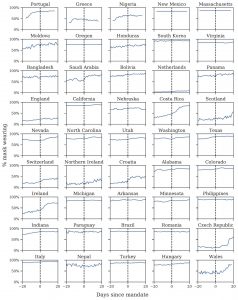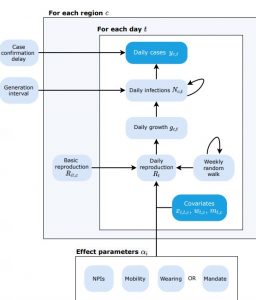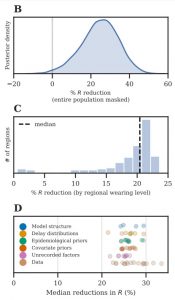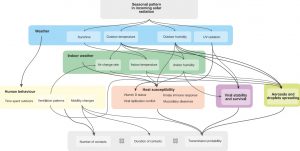This week’s post is written by IAI CDT student Gavin Leech.
I recently worked on two papers looking at neglected aspects of the COVID-19 pandemic. I learned more than I wanted to know about epidemiology.
The first: how much do masks do?
There were a lot of confusing results about masks last year.
We know that proper masks worn properly protect people in hospitals, but zooming out and looking at the population effect led to very different results, from basically nothing to a huge halving of cases.
Two problems: these were, of course, observational studies, since we don’t run experiments on the scale of millions. (Or not intentionally anyway.) So there’s always a risk of missing some key factor and inferring the completely wrong thing.
And there wasn’t much data on the number of people actually wearing masks, so we tended to use the timing of governments making it mandatory to wear masks, assuming that this caused the transition to wearing behaviour.
It turns out that the last assumption is mostly false: across the world, people started to wear masks before governments told them to. (There are exceptions, like Germany.) The correlation between mandates and wearing was about 0.32. So mask mandate data provide weak evidence about the effects of mass mask-wearing, and past results are in question.

We use self-reported mask-wearing instead: the largest survey of mask wearing (n=20 million, stratified random sampling) and obtain our effect estimates from 92 regions across 6 continents. We use the same model to infer the effect of government mandates to wear masks and the effect of self-reported wearing. We do this by linking confirmed case numbers to the level of wearing or the presence of a government mandate. This is Bayesian (using past estimates as a starting point) and hierarchical (composed of per-region submodels).

For an entire population wearing masks, we infer a 25% [6%, 43%] reduction in R, the “reproduction number” or number of new cases per case (B).
In summer last year, given self-reported wearing levels around 83% of the population, this cashed out into a 21% [3%, 23%] reduction in transmission due to masks (C).

One thing which marks us out is being obsessive about checking this is robust; that different plausible model assumptions don’t change the result. We test 123 different assumptions about the nature of the virus, of the epidemic monitoring, and about the way that masks work. It’s heartening to see that our results don’t change much (D)
It was an honour to work on this with amazing epidemiologists and computer scientists. But I’m looking forward to thinking about AI again, just as we look forward to hearing the word “COVID” for the last time.
The second: how much does winter do?
We also look at seasonality: the annual cycle in virus potency. One bitter argument you heard a lot in 2020 was about whether we’d need lockdown in the summer, since you expect respiratory infections to fall a lot in the middle months.
We note that the important models of what works against COVID fail to account for this. We look at the dense causal web involved:

This is a nasty inference task, and data is lacking for most links. So instead, we try to directly infer a single seasonality variable.

It looks like COVID spreads 42% less [25% – 53%, 95% CI] from the peak of winter to the peak of summer.
Adding this variable improves two of the cutting-edge models of policy effects (as judged by correcting bias in their noise terms).
One interesting side-result: we infer the peak of winter, we don’t hard-code it. (We set it to the day with the most inferred spread.) And this turns out to be the 1st January! This is probably coincidence, but the Gregorian calendar we use was also learned from data (astronomical data)…
—
See also
Mass mask-wearing notably reduces COVID-19 transmission (under review at PNAS)
- Gavin Leech, Charlie Rogers-Smith, Jonas B. Sandbrink, Benedict Snodin, Robert Zinkov, Benjamin Rader, John S. Brownstein, Yarin Gal, Samir Bhatt, Mrinank Sharma, Sören Mindermann, Jan M. Brauner, Laurence Aitchison
Seasonal variation in SARS-CoV-2 transmission in temperate climates
- Tomas Gavenciak, Joshua Teperowski Monrad, Gavin Leech, Mrinank Sharma, Soren Mindermann, Jan Markus Brauner, Samir Bhatt, Jan Kulveit
Understanding the effectiveness of government interventions against the resurgence of COVID-19 in Europe (Nature Comms)
- Mrinank Sharma, Sören Mindermann, Charlie Rogers-Smith, Gavin Leech, Benedict Snodin, Janvi Ahuja, Jonas B. Sandbrink, Joshua Teperowski Monrad, George Altman, Gurpreet Dhaliwal, Lukas Finnveden, Alexander John Norman, Sebastian B. Oehm, Julia Fabienne Sandkühler, Laurence Aitchison, Tomáš Gavenčiak, Thomas Mellan, Jan Kulveit, Leonid Chindelevitch, Seth Flaxman, Yarin Gal, Swapnil Mishra, Samir Bhatt & Jan Markus Brauner
